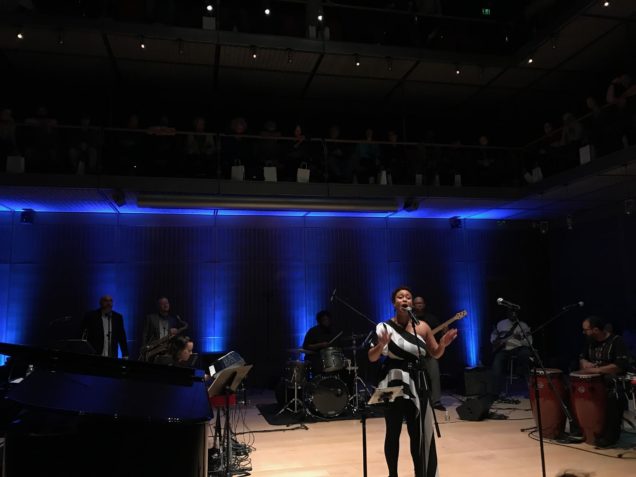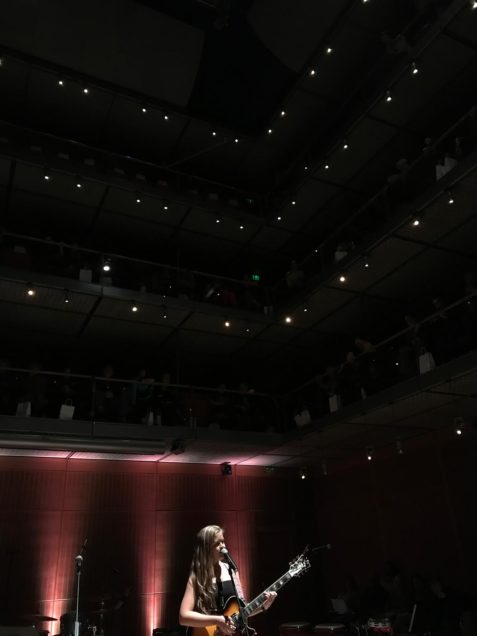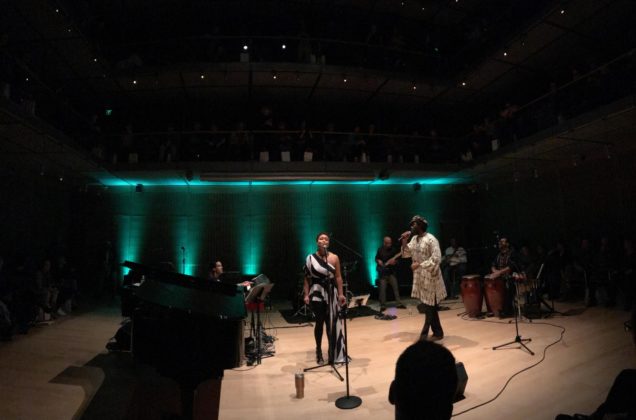REVIEW: The A-Beez, Emily Elbert, Camille Merendail, DJ L’Duke @ Isabella Stewart Gardner Museum 03/22

On Thursday, March 22, Boston’s the A-Beez performed at the Isabella Stewart Gardner Museum to debut their new album titled Say Goodbye. The show was held in the museum’s Calderwood Hall, a venue unlike any I have ever seen. It is the shape of a cube, with chairs set up on the floor right next to the band and four more floors ascending to the ceiling, with two rows of seating on each floor. There were also rows and rows of lights which looked like stars when the lights went dim, and created a very ethereal and relaxing environment. The A-Beez’s set was opened by Camille Merendail and Emily Elbert, with DJ L’Duke providing some pre-show beats.
Camille Merendail, only fourteen years old, sang her own renditions of Amy Winehouse’s “Back to Black” and Hozier’s “Take Me to Church” with impeccable vocals. She was accompanied by an acoustic guitar and piano player.
Emily Elbert, a singer-songwriter who attended Berklee College and has multiple EP’s available on iTunes, followed up with some soulful, well-written originals. Elbert’s silky, feminine, but deep voice, accompanied by her stellar electric guitar skills, provided for a very serene and sincere musical performance. From upbeat, jazzy tunes like “Come Too Far” and “Visitor” to more heartfelt, subtle songs like “Easily” and “Here and Now,” Elbert proved to be a very talented musician, with the ability to write complex and genuine lyrics. The song that stole the show, “True Power,” was a politically charged, rock ’n’ roll/bluesy jam, criticizing President Trump with lyrics like “soak up the scandal drink up the diversion” and “fear monger your days are numbered.”
As we waited for The A-Beez to come out, I could tell there were a lot of locals there ready to listen to a band they knew and loved. Having never heard of the A-Beez, a group started by husband and wife Aaron and Amy Bellamy, I drew from the crowd’s excitement and was not disappointed when they finally took the stage. The group’s sound cannot really be categorized into one or even a couple genres. Their music has elements of jazz, funk, blues, and even a hint of psychedelic. The combination of multiple instruments—piano (Amy Bellamy’s an amazing pianist), drums, bass (Aaron Bellamy’s forté), guitar, trombone, saxophone, congas, and even chimes—matched with Melissa Bolling’s and Toussaint Liberator’s vocals, provided groovy, get-up-out of your seat, bob your head types of arrangements that had the whole audience dancing throughout the show.
They started out with the funky, instrumental tune “Everything Must Go,” which included what I assumed to be some killer improvisations from the horns. The next song, “Folded Flower,” a smooth, jazzy, but funky beat, introduced Melissa Bolling’s vocals to the mix. Bolling had the perfect jazz voice with a wide range and an effortless vibrato. For the next song, “Hey Neighbor,” Bolling was accompanied by Toussaint Liberator, whose voice reminded me a bit of Stevie Wonder, for a super groovy and upbeat, conga-heavy jam about “opening up your heart.”
The next few songs off the album—“Say Goodbye,” “Popcorn Scrimpz,” and “Without You” — further displayed the group’s remarkable instrumental talent and ability to play off of each other’s improvisations. “Without You” particularly stood out, as the crowd snapped along to the beat, and was accompanied by silky harmonizations from the vocalists. This tune made me feel like I was sitting on the porch on a warm and sunny Sunday afternoon. The band ended the set with “Threatening Black Male,” an energetic, almost tropical-sounding dancey jam (which included a fun and intense conga solo) sung by Toussaint Liberator, and “It’s Gone,” an ethereal, slower song with more relaxed instrumentals (and a soulful, smooth guitar solo) in which Bolling showed off Mariah Carey-esque high notes.
The A-Beez came back for an encore, to play a song called “Patch” written by Amy Bellamy and Sinclair Jennings, before he passed away four years ago; she told the crowd they’d built the song around his vocals. The song started with an understated intro with funky bass and an ethereal, high-pitched keyboard. The tempo increased as the song went on, leading up to a dramatic pause and a strong instrumental finish. The crowd, including myself, showed our appreciation for he A Beez’s musical talent with a standing ovation to finish the night.
-Hannah Rogers


